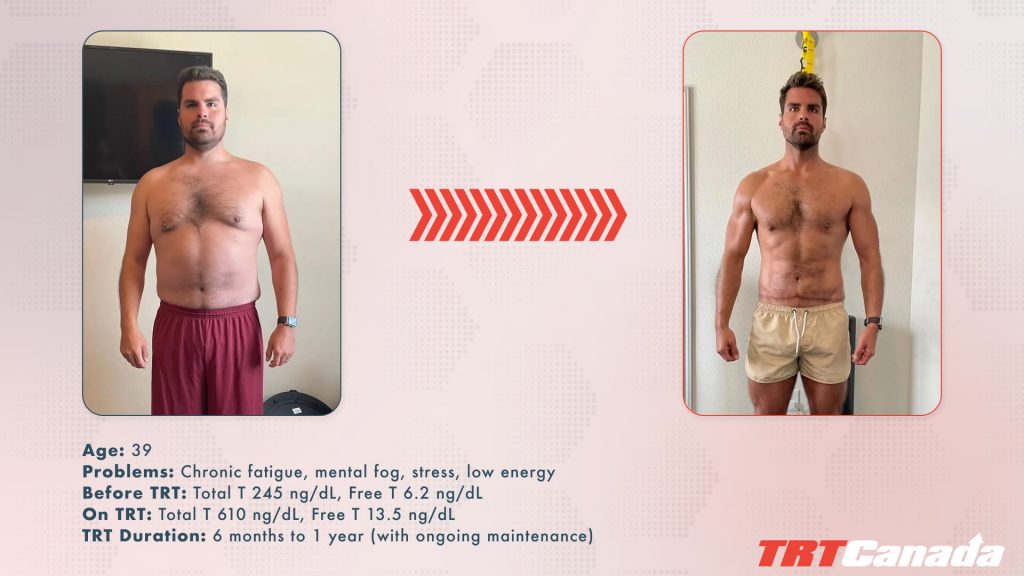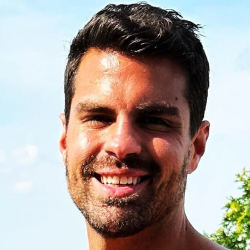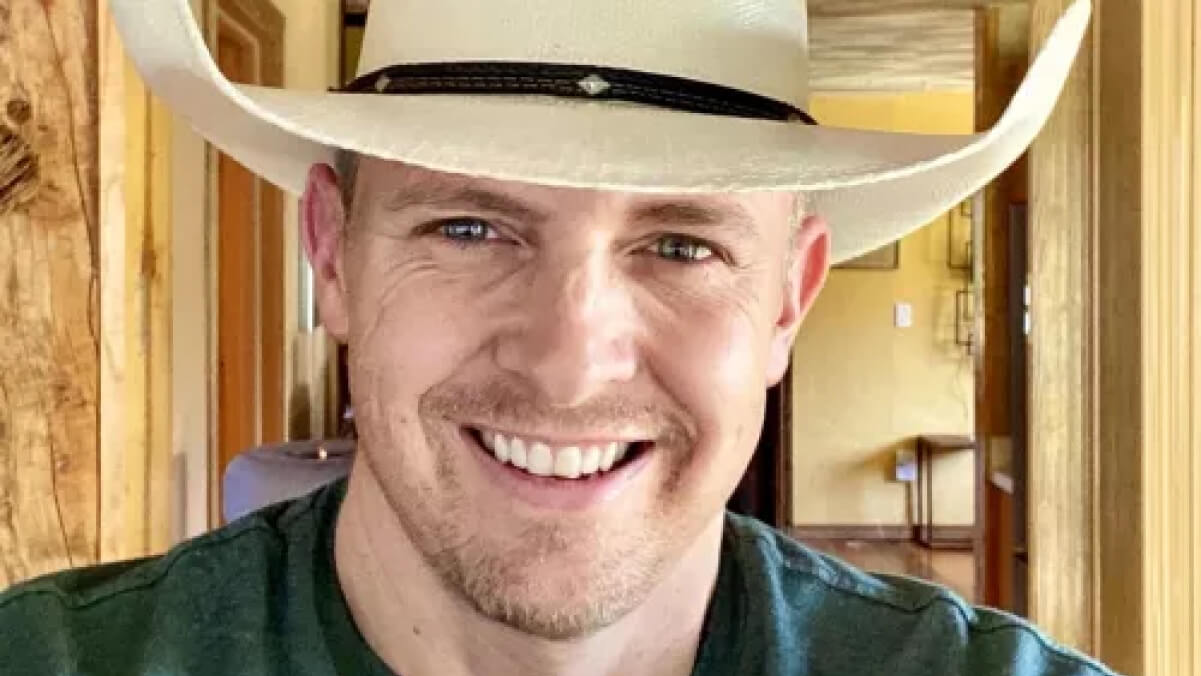
Ben Thompson, a 39-years-old realtor, was running his own agency, having it all at the palm of his hand. Ben’s thriving business gave him the freedom to set his own hours and travel at will with a devoted wife and his teenage daughter. His household was filled with opportunities and laughter, yet he found himself unable to enjoy the life he built.
What used to be an abundance of ambition and plans for the future was now replaced with a daily struggle to keep moving through the day. His interest in fitness had faded, because workouts left him too drained to move a finger afterwards.Even his personal life had suffered, the spontaneous family activities were out of discussion, whereas intimacy had lost its spark.
After careful evaluation of the symptoms, Ben started thinking about TRT. He discovered (independent bloodwork test in one of Toronto’s clinics) that his testosterone levels were far below the ideal range for a man of his age. But when and how did it begin?
Symptoms Manifestation: A Few Years Before Going on TRT
Ben first noticed changes in his energy levels a few years ago. Initially, he blamed it on his unpredictable schedule. Running a real estate agency often meant late-night negotiations, weekend open houses, and back-to-back client meetings. But as time went on, his fatigue reached new extremes. Even after a solid eight hours of sleep, Ben woke up feeling lethargic.
Social events and networking gatherings — once thrilling opportunities to meet new clients — turned into obligations. At the gym, his previous routine felt like too much. A single workout would leave him sapped for days, causing aches and muscle pains.
“I’ve been yawning my way through the day and dozing off by nine. I’m 39, but my body feels twice that age.”
At first, Ben wondered if he was simply facing the reality of a stressful career and middle age. But the changes were too abrupt and disruptive, so the complete medical checkup was up to due. He hoped to find a straightforward explanation — perhaps a vitamin deficiency, or maybe just an elevated cholesterol level. Yet, Ben has contemplated if his testosterone levels were in order.
A Consultation that Changed Ben’s Life
Ben had booked a consultation with one of the TRT Canada’s specialists, where he received a recommendation for a full blood panel, including total and free testosterone levels.
Ben’s initial total testosterone level has been around 298 ng/dL, whereas for a man in his 40’s, ideal level would sit anywhere between 400 to 900 ng/dL. It was well below what the experts consider optimal.
Moreover, his free testosterone — the unbound hormone that exerts the most vital effects — was dismally low at 5.9 ng/dL. This explained not only his constant fatigue but also the lag in muscle recovery, decreased libido, and lack of mental clarity.
Following the initial blood analysis, Ben sought a second opinion from an independent endocrinologist, who confirmed the diagnosis.
Realizing that he needed specialized support, Ben decided to keep working with TRT Canada experts to ensure accuracy and create a baseline for treatment, while devising a treatment plan that addressed his individual needs.
Experts Recommendation and Treatment Plan
TRT Canada specialists had recommended a long-acting testosterone ester administered through weekly moderate doses. The goal was never to push Ben into unnaturally high testosterone levels, but to nudge him back toward a healthier, more balanced state.
For the first two months, the clinical team kept a close watch on how his body responded, checking his blood regularly. Ben agreed to follow-up blood tests at the 6-week, 12-week, 6-month, 9-month and 12-month marks, which would allow for adjustments if his estradiol rose too high or if other parameters — such as hematocrit — strayed from safe ranges.
The TRT Canada’s team has emphasized realistic timelines: major improvements might take a few months, although many patients observe subtle changes — like slightly better sleep or improved mood — in as little as four to six weeks. The most transformative improvements often emerge around the three-to-six-month window.
They also underscored the importance of adhering to the recommended injection schedule, adjusting the dosage if future bloodwork indicated a need.
First Results on TRT
Initially, Ben noticed small wins. By the end of the first month, waking up in the morning felt a tad easier. He could get through a long day of property tours without experiencing the familiar 2pm crash.
At the 6-week blood draw, results indicated a mild uptick in total testosterone — rising into the 400–450 ng/dL range — and an increase in free testosterone. Encouraged by the progress, the clinic kept Ben on the same dosing schedule to let the therapy “settle in.”
By the time three months had passed, his total T edged closer to 600 ng/dL, and free T hovered around 12–14 ng/dL, which many experts consider a robust, healthy zone for a man in his mid-40s.
Four Months Mark on TRT: Shifting the Balance
It was around the four-month mark that Ben noticed that things turned for the better. Work became stimulating again, rather than a never-ending slog. His teenage daughter joked that her dad was finally “getting fun” again, taking a more active role in family outings.
Six months into the program, Ben hit a sweet spot. His bloodwork stabilized, showing a total testosterone consistently in the 600–650 ng/dL range, with free testosterone around 14–15 ng/dL. His energy soared, gym sessions became productive rather than punishing, and his interpersonal relationships flourished. The TRT Canada team continued to monitor his estradiol, hematocrit, and other critical variables, ensuring no adverse changes cropped up.
“It was like a weight lifted off my shoulders. I still have a million things to juggle, but I’m not drowning anymore. I feel like myself — the self I almost forgot existed.”
The Road Ahead: Ben’s Plans for the Future
Reflecting on the experience, Ben often mentions how integral TRT Canada clinic’s patient-focused approach was to his success. From the thorough initial assessment and customized TRT protocol to the lifestyle coaching and constant follow-ups, he felt guided and supported every step of the way.
John says he now actively promotes to his friends & colleagues the idea that feeling chronically tired, foggy, or moody is not an acceptable “new normal.” By addressing the root cause, rather than masking symptoms, he found a pathway to reclaim lost energy.
YOUR OWN JOURNEY TO HORMONAL BALANCE, OPTIMIZED PERFORMANCE AND PEAK PHYSIQUE CAN START NOW: WITH TRT CANADA







